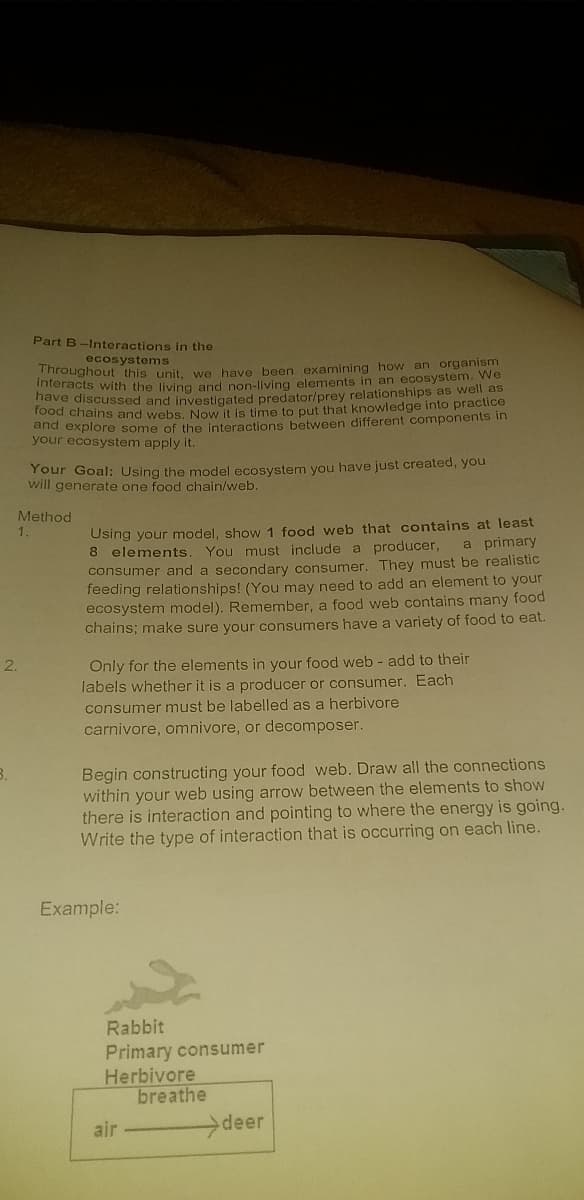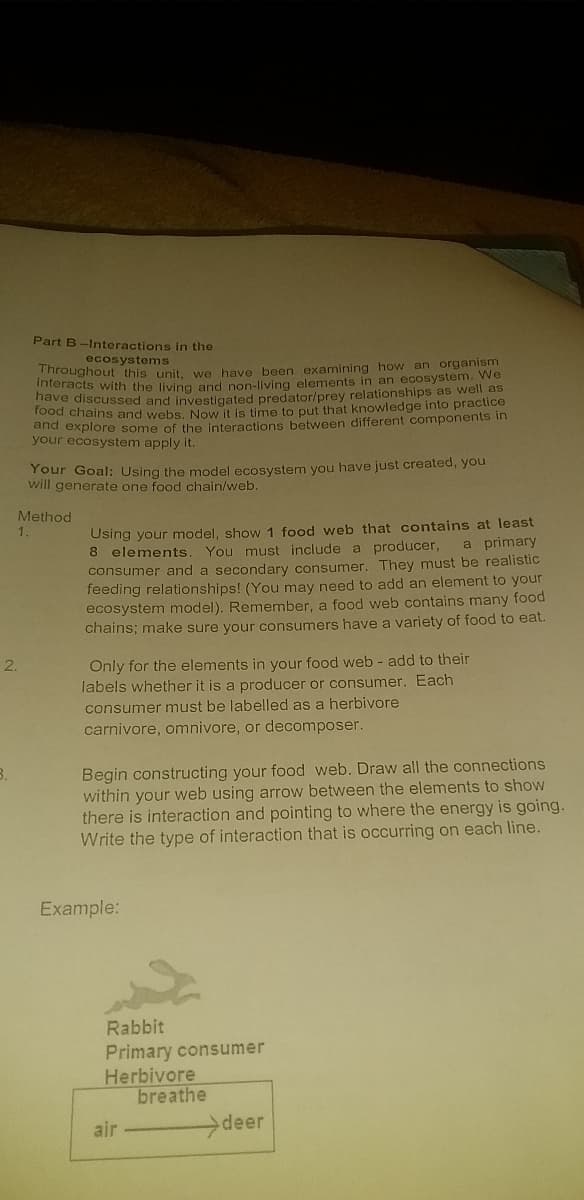Part B-Interactions in the ecosystems Throughout this unit, we have been examining how an organism teracts with the living and non-living elements in an ecosystem. We have discussed and investigated predator/prey relationships as well as Tood chains and webs. Now it is time to put that knowledge into practice and explore some of the interactions between different components in your ecosystem apply it. Your Goal: Using the model ecosystem you have just created, you will generate one food chain/web. Method Using your model, show 1 food web that contains at least 8 elements. You must include a producer, consumer and a secondary consumer. They must be realistic feeding relationships! (You may need to add an element to your ecosystem model). Remember, a food web contains many food chains; make sure your consumers have a variety of food to eat. 1. a primary Only for the elements in your food web - add to their labels whether it is a producer or consumer. Each consumer must be labelled as a herbivore carnivore, omnivore, or decomposer. Begin constructing your food web. Draw all the connections within your web using arrow between the elements to show there is interaction and pointing to where the energy is going. Write the type of interaction that is occurring on each line. Example: Rabbit Primary consumer Herbivore breathe air deer
Part B-Interactions in the ecosystems Throughout this unit, we have been examining how an organism teracts with the living and non-living elements in an ecosystem. We have discussed and investigated predator/prey relationships as well as Tood chains and webs. Now it is time to put that knowledge into practice and explore some of the interactions between different components in your ecosystem apply it. Your Goal: Using the model ecosystem you have just created, you will generate one food chain/web. Method Using your model, show 1 food web that contains at least 8 elements. You must include a producer, consumer and a secondary consumer. They must be realistic feeding relationships! (You may need to add an element to your ecosystem model). Remember, a food web contains many food chains; make sure your consumers have a variety of food to eat. 1. a primary Only for the elements in your food web - add to their labels whether it is a producer or consumer. Each consumer must be labelled as a herbivore carnivore, omnivore, or decomposer. Begin constructing your food web. Draw all the connections within your web using arrow between the elements to show there is interaction and pointing to where the energy is going. Write the type of interaction that is occurring on each line. Example: Rabbit Primary consumer Herbivore breathe air deer
Biology: The Unity and Diversity of Life (MindTap Course List)
15th Edition
ISBN:9781337408332
Author:Cecie Starr, Ralph Taggart, Christine Evers, Lisa Starr
Publisher:Cecie Starr, Ralph Taggart, Christine Evers, Lisa Starr
Chapter48: Human Impacts On The Biosphere
Section: Chapter Questions
Problem 3CT
Related questions
Question

Transcribed Image Text:Part B-Interactions in the
ecosystems
Throughout this unit we have been examining how an organism
Interacts with the living and non-living elements in an ecosystem. We
Fve discussed and investigated predator/prey relationships as well as
Tood chains and webs, Now it is time to put that knowledge into practice
and explore some of the interactions between different components in
your ecosystem apply it.
Your Goal: Using the model ecosystem you have just created, you
will generate one food chain/web.
Method
1.
Using your model, show 1 food web that contains at least
8 elements. You must include a producer,
consumer and a secondary consumer. They must be realistic
feeding relationships! (You may need to add an element to your
ecosystem model). Remember, a food web contains many food
chains; make sure your consumers have a variety of food to eat.
a primary
Önly for the elements in your food web - add to their
labels whether it is a producer or consumer. Each
consumer must be labelled as a herbiyore
2.
carnivore, omnivore, or decomposer.
Begin constructing your food web. Draw all the connections
within your web using arrow between the elements to show
there is interaction and pointing to where the energy is going.
Write the type of interaction that is occurring on each line.
B.
Example:
Rabbit
Primary consumer
Herbivore
breathe
air
deer

Transcribed Image Text:Part B-Interactions in the
ecosystems
Throughout this unit we have been examining how an organism
Interacts with the living and non-living elements in an ecosystem. We
Fve discussed and investigated predator/prey relationships as well as
Tood chains and webs, Now it is time to put that knowledge into practice
and explore some of the interactions between different components in
your ecosystem apply it.
Your Goal: Using the model ecosystem you have just created, you
will generate one food chain/web.
Method
1.
Using your model, show 1 food web that contains at least
8 elements. You must include a producer,
consumer and a secondary consumer. They must be realistic
feeding relationships! (You may need to add an element to your
ecosystem model). Remember, a food web contains many food
chains; make sure your consumers have a variety of food to eat.
a primary
Önly for the elements in your food web - add to their
labels whether it is a producer or consumer. Each
consumer must be labelled as a herbiyore
2.
carnivore, omnivore, or decomposer.
Begin constructing your food web. Draw all the connections
within your web using arrow between the elements to show
there is interaction and pointing to where the energy is going.
Write the type of interaction that is occurring on each line.
B.
Example:
Rabbit
Primary consumer
Herbivore
breathe
air
deer
Expert Solution
This question has been solved!
Explore an expertly crafted, step-by-step solution for a thorough understanding of key concepts.
This is a popular solution!
Trending now
This is a popular solution!
Step by step
Solved in 2 steps with 1 images

Knowledge Booster
Learn more about
Need a deep-dive on the concept behind this application? Look no further. Learn more about this topic, biology and related others by exploring similar questions and additional content below.Recommended textbooks for you

Biology: The Unity and Diversity of Life (MindTap…
Biology
ISBN:
9781337408332
Author:
Cecie Starr, Ralph Taggart, Christine Evers, Lisa Starr
Publisher:
Cengage Learning

Biology: The Unity and Diversity of Life (MindTap…
Biology
ISBN:
9781337408332
Author:
Cecie Starr, Ralph Taggart, Christine Evers, Lisa Starr
Publisher:
Cengage Learning